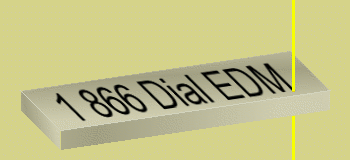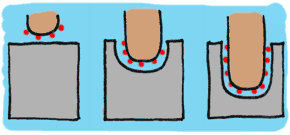



 Basic ConceptEDM is a machining process which consists of removing material from a workpiece, using electrical discharges as the means of machining. This technique is characterized by its aptitude for machining all materials that conduct electricity (metals, alloys, carbides, graphite, etc.) whatever their hardness may be. To machine with this process, 4 items are required:    The purpose of the dielectric (water or mineral oil) is to lower the temperature in the machining area, remove the residual metallic particles, and enable sparks to be created. Electrical Discharge Machining (EDM)Produced by a spark generator, the sparks at regular intervals create a succession of craters in the workpiece. Each spark ranges in temperature between 8,000 and 12,000° C. The size of the crater depends on the energy turned out by the spark generator. The range of the sparks varies from a few microns to 1 mm.  EDM ProcessThe EDM process takes place in 6 stages.  2. Concentration of the electrical field towards the point where the space between the electrode and workpiece is smallest.  3. Creation of an ionized channel between the electrode and workpiece.  4. Breakdown of the spark. The workpiece material melts locally and disintegrates. The electrode only wears out slightly.  5. The current is cut off, causing implosion of the spark.  6. Evacuation of the metallic particles by flushing with dielectric.  Facts about EDM* EDM wire cutting uses a metallic wire (electrode) to cut a programmed contour in a workpiece. * Extrusion dies and blanking punches are very often machined by wire cutting. * Wire EDM machining always cuts through the entire workpiece. * To start machining, it is first necessary to drill a hole in the workpiece or start from the edge. * In the machining area, each discharge creates a crater in the workpiece (material removal) and an impact on the tool (wear of the tool/electrode). * The wire can be inclined, thus making it possible to make parts with taper or with different profiles at the top and bottom. * There is never any mechanical contact between the electrode and workpiece. * The wire is usually made of brass or stratified copper, and is between 0.02 and 0.03 mm diameter. |